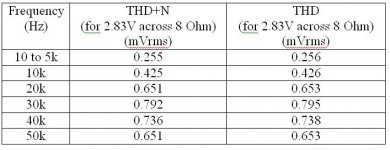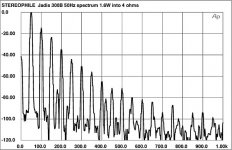I am designing out the 2'nd harmonic distortion in the next generation of JC-1. Doubt that it will make any sonic difference.
I thought you did that 40 years ago.
jn
As you can hear 30 db into the noise floor (Depending on how you define noise) saying it can't be measured with the equipment they were using then isn't really informative.
Then there is the issue of what the noise floor is! Op-amps of the day were not exactly quiet.
At the 4th paragraph of Stereophile’s measurements you’ll find this:
Noise (unweighted, ref. 1W into 8 ohms) measured –88dB, either balanced or unbalanced.
That’s 0.113mVrms across an 8 Ohm load. This is unweighted Noise with no input signal.
Measurements of first watt performance are probably more telling.
In the text, they say that the 1 watt residual is noise-dominated. So the crossover song and dance is just a deliberate distraction.
You are right, but only if noise is all the sound there is, that is in a no signal situation.In that case, there will not be any distortion produced.
In case of a signal, we are talking about 1 W output by means of example here, there will be a lot of sound produced, way above the noise floor. It is a nonsense to speak in that case of being able to hear 30dB below the noise floor. With the kind of amplifiers we are discussing here, you won't even be able to hear the noise itself at much lower output levels, let alone that you can hear anything 30 dB below it. Remember the marching band?
Yes, yes, yes.
There is Fig.4 (THD+N (%) vs frequency at 2.83V).
Acc to this diagram, for 8Ohm load we get:
http://www.diyaudio.com/forums/attachment.php?attachmentid=431746&stc=1&d=1407353055
Plug in the sensitivity figure of your speakers and think if you can hear the Noise, the THD+N and the THD that this robust PA amplifier produces.
George
Attachments
Last edited:
The fiber optic thing? yes we sold quite a few. Got reviews from other rags internationally. All were positive. My favorite was the CD lens spatial filter. Stereophile did print a paper we did on it because there was real science behind it. The best reaction was from Krell. everyone in the room heard a marked improvement on their flagship machine, but they insisted it did not make a difference...Hee Hee. I also wrote an explanation on why demagnetizing CD's worked. Wasn't my product but it turns out there is an affect on the dipole moments and thus a change in the birefringence of poly-carbonate thus reducing the critical angle of light within the boundaries of the CD and hence a reduction in background optical noise. The spacial filter did it much better though. also reducing the optical phase modulation. Stereophile didn't print that one.
John: What about Corey Greenberg? I had a distribute from Asia tell me my product would be hard to sell because cable companies make up the majority of advertisement revenue for audio rags. The analog fiber optic interconnect did outperform many cables out to 5 kilometers of so. It was based on a fiber optic hydrophone system for submarines. Stereophile just refused to review it. Cutting edge, eh?
Did you request a review, how ..... ?
Is that what "DIY" means - I thought it means ask someone else what commercial equipment I should like, then ask what I should do to 'recap' it so that it sounds like what someone else prefers, then throw it away and start again when my wife in the kitchen says she doesn't like it. Am I on the right forum?
You left out chimps ....

Of course, there is some crossover distortion, that is almost the only way to make higher order harmonics without coming near clipping.
Unless you're a fashion audio designer.
Attachments
BTW, JC1 has high 2nd.
How important ? You should check out the Ayre amplfiers , toobs ..
Canyoncruz, two questions.
1. What in polycarbonate can hold a magnetic dipole moment? This would seem to be a requirement before any demagnetization can take place to begin with.
2. Within very broad limits of initial reading errors, the reconstruction algorithms can rebuild the original bitstream with 100 percent confidence. So how can diffraction in well surfaces or whatever it was make any diffrence?
1. What in polycarbonate can hold a magnetic dipole moment? This would seem to be a requirement before any demagnetization can take place to begin with.
2. Within very broad limits of initial reading errors, the reconstruction algorithms can rebuild the original bitstream with 100 percent confidence. So how can diffraction in well surfaces or whatever it was make any diffrence?
Last edited:
Unless you're a fashion audio designer.
wow , you have them beat by 5 watts .....

Did you have enough established dealers to qualify for a review in Stereophile. The CTC Blowtorch was also NOT REVIEWED by Stereophile for this reason.
They appear to have changed this policy, at least somewhat.
I also wrote an explanation on why demagnetizing CD's worked. Wasn't my product but it turns out there is an affect on the dipole moments and thus a change in the birefringence of poly-carbonate thus reducing the critical angle of light within the boundaries of the CD and hence a reduction in background optical noise.
Have you tested the case of birefringence due to stress? (stresses induced during manufacture of the disk or occurring during rotation)
George
They appear to have changed this policy, at least somewhat.
They still require at least 5 retailers to carry a product before they will review it.
jan
Have you tested the case of birefringence due to stress? (stresses induced during manufacture of the disk or occurring during rotation)
George
Ah, but how does that affect dipole moment and demagnetization?
jn
George,
I haven't looked at the circuit, but Crown would use a variable gain circuit rather than a straight potentiometer is some of their amplifiers. So if that is the case for this unit with the volume set for minimum that is actually a bad S/N ratio!
In any case Crown usually specified S/N from full power and it would generally be above 100 db flat or 105 A weighted. Good but not the best.
However the fundamental issue is that it is silly to expect a monster power amplifier to behave the same as a low power type. I would not use it to drive tweeters in a home system. (I have used MA5000s to drive tweeters in a large system. After removing the factory installed protection crossovers with an inductor that saturated at normal levels the system worked well.)
I haven't looked at the circuit, but Crown would use a variable gain circuit rather than a straight potentiometer is some of their amplifiers. So if that is the case for this unit with the volume set for minimum that is actually a bad S/N ratio!
In any case Crown usually specified S/N from full power and it would generally be above 100 db flat or 105 A weighted. Good but not the best.
However the fundamental issue is that it is silly to expect a monster power amplifier to behave the same as a low power type. I would not use it to drive tweeters in a home system. (I have used MA5000s to drive tweeters in a large system. After removing the factory installed protection crossovers with an inductor that saturated at normal levels the system worked well.)
I also wrote an explanation on why demagnetizing CD's worked. Wasn't my product but it turns out there is an affect on the dipole moments and thus a change in the birefringence of poly-carbonate thus reducing the critical angle of light within the boundaries of the CD and hence a reduction in background optical noise.
I thought de-magnetization was a randomization process why a priory would a random CD blank come out "bad" and always get "better" especially the ones that read with no uncorrected errors. The physics papers are all gobbledygook to me, I would have to defer to SY on the ability of your average tape de-magnetiser to re-orient PC molecules.
I found my reference from the folks that supposedly used a SQUID magnetometer to measure LP's before/after treatment (I think this data was even used by Furutech). It was 500-550nT and the change averaged 50nT only 10% (hardly de-magnetized). So this effect two orders of magnitude less with a change of three orders of magnitude less than the earth's background is "dramatic". I can assure you the wife in the kitchen wielding knives and opening and closing all those magnetic latches is a larger effect. Maybe jn could compute it.
I would have to defer to SY on the ability of your average tape de-magnetiser to re-orient PC molecules.
Not even close. PC molecules are essentially unaffected by magnetic fields. You might get some re-orientation under high electric field combined with heating above Tg, but why bother? Read errors are pretty infrequent, it's a robust medium. And like all other physical media, it's going away in favor of downloads.
Unless you're a fashion audio designer.
SY,
That is the wrong graph to show why the 300B is so popular. The 300B is a directly heated cathode. It was designed for very long service life and has a very sturdy filament. As a result it has a fairly decent well damped low end mechanical resonance. That really does sweeten up the music.
It is possible one of my trade secrets is to add some low frequency resonances in large scale sound systems to improve what is perceived as intimacy.
ES
- Status
- Not open for further replies.
- Home
- Member Areas
- The Lounge
- John Curl's Blowtorch preamplifier part II

